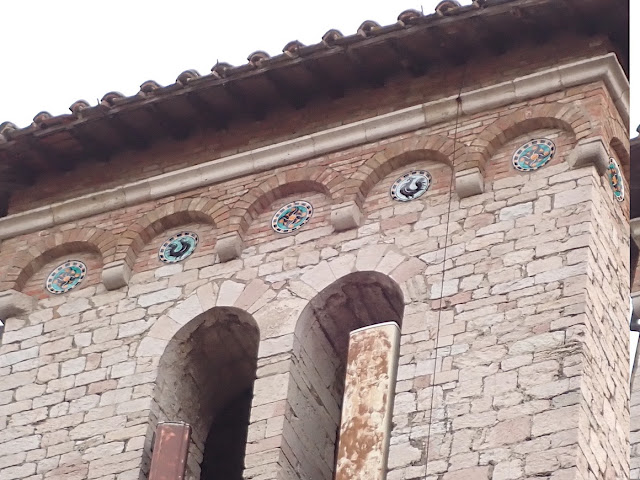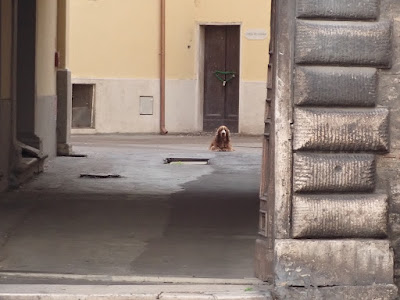 I was excited
to visit Perugia, having not returned to this lovely city since 2007. Perugia is home to one of the oldest
universities in Italy (founded in 1308), and also is home to both Perugina, the
chocolate company, as well as Eurochocolate, an
I was excited
to visit Perugia, having not returned to this lovely city since 2007. Perugia is home to one of the oldest
universities in Italy (founded in 1308), and also is home to both Perugina, the
chocolate company, as well as Eurochocolate, an  international chocolate
festival. With that kind of background,
who would not be thrilled?!? And ready for (you guessed it) CHOCOLATE!
international chocolate
festival. With that kind of background,
who would not be thrilled?!? And ready for (you guessed it) CHOCOLATE!
However,
prior to visiting the city itself we had another stop, and wow, that was
probably the most amazing place to  visit!
visit!
In Perugia
one can go to a traditional weaving studio, where artists create incredible fabrics using not only the same methods and designs but also the same looms used
hundreds of years ago! Really! The Giuditta Brozzetti Museum Atelier
is both
a museum and studio devoted to the art of weaving.
They are
housed in an old church, aptly named the Church of St. Francis of the
Women. Current owner is Marta Cucchia, a
fourth-generation master weaver and great granddaughter of the weaver for whom
the  studio is named.
studio is named.
The website: https://www.brozzetti.com/en/history/tradition/
And a video,
in Italian, of Marta being interviewed for a documentary film  about traditional
arts in Italy (we think – my Italian is limited): https://www.youtube.com/watch?v=4q7A-j71FME&ab_channel=Bellezzaepotereprogrammatelevisivo
about traditional
arts in Italy (we think – my Italian is limited): https://www.youtube.com/watch?v=4q7A-j71FME&ab_channel=Bellezzaepotereprogrammatelevisivo
 The studio specializes
in jacquard weaving. Jacquard weaving is
pictorial, usually in repeated patterns, but differs from tapestry weaving in
several ways. First, both the warp and
weft threads (vertical and horizontal threads) are visible in the finished
fabric; in tapestry
The studio specializes
in jacquard weaving. Jacquard weaving is
pictorial, usually in repeated patterns, but differs from tapestry weaving in
several ways. First, both the warp and
weft threads (vertical and horizontal threads) are visible in the finished
fabric; in tapestry  weaving, the weft threads completely cover the warp threads. Second, the design is visible from both the
front and back of the cloth, while in tapestry weaving the back is usually
covered and not made to be viewed. And
last, in jacquard weaving the weft threads are woven across the entire
weaving, the weft threads completely cover the warp threads. Second, the design is visible from both the
front and back of the cloth, while in tapestry weaving the back is usually
covered and not made to be viewed. And
last, in jacquard weaving the weft threads are woven across the entire  horizontal
width of the fabric; in tapestry weaving uses multiple weft threads that cover
only the section of fabric for each color that create the image.
horizontal
width of the fabric; in tapestry weaving uses multiple weft threads that cover
only the section of fabric for each color that create the image.
Marta took us
around the studio and showed us some of the looms, hand-carved in wood, and
several hundred years  old. (I think the
oldest loom was originally made in 1400-something, but that might have been 1500-something.) Decoratively-carved end pieces and braces to
help support uprights, because they were made in an era where even utilitarian items were beautiful!
old. (I think the
oldest loom was originally made in 1400-something, but that might have been 1500-something.) Decoratively-carved end pieces and braces to
help support uprights, because they were made in an era where even utilitarian items were beautiful!  Hand-carved wood
gears and cogs! The looms were works of
art themselves!
Hand-carved wood
gears and cogs! The looms were works of
art themselves!
She also
demonstrated how jacquard is woven. The
patterns are based on a grid system, and each design needs certain warp  threads
to be lifted or lowered as the weft threads are drawn through. Metal punch cards are created for each design,
one per row of weave, and are attached to each other, making a long chain for the design – somewhat like
a roll of music on a metal sheet for a player piano. The long chain of cards runs through a device on the
top of each loom, and the punch cards indicated which warp threads are lifted
or lowered. (This is the super simplified
explanation, because the way the warp threads are lifted gets really
complicated to describe.)
threads
to be lifted or lowered as the weft threads are drawn through. Metal punch cards are created for each design,
one per row of weave, and are attached to each other, making a long chain for the design – somewhat like
a roll of music on a metal sheet for a player piano. The long chain of cards runs through a device on the
top of each loom, and the punch cards indicated which warp threads are lifted
or lowered. (This is the super simplified
explanation, because the way the warp threads are lifted gets really
complicated to describe.)
It was
absolutely fascinating to watch Marta weave!
Some of the looms are a good six feet (two meters) wide, and there’s a
special bobbin sort of thing (called a shuttle) for the weft thread – it just
flies through the warp threads, then the beater sort of combs the weft back and
makes a nice tight weave. There are
multiple parts in motion, from the treadle that lifts the heddles which control
the warp threads, to the shuttle flying back and forth, to the beater – plus a
button that advances the punch card chain – whew!
PLUS! That chain of punch cards can be run
BACKWARDS, to create a mirror image of the design just woven! So a weaver could create fabric with a line
of lions, standing on a small row of flowers, with a second line of lions that
are upside down, like a reflection!
Amazing!!!
We all were in
weaving heaven! People were asking
questions, taking photos, asking more questions – and then shopping. The finished products were SO gorgeous, and
trying to decide whether or not to buy something, and then which one to buy, became
a major decision! When everything is
beautiful, how do you pick just one item?
I solved it by
not buying anything, since we don’t have a permanent home. Makes it easier. But oh, if I did have a permanent home, it
would be so so tempting to buy, oh, a table runner. Covers for throw pillows. A wall hanging. Everything truly was a work of art!
Also, I swear
I have been here before! I suspect it
was during my first class at La Romita, in 2007. We walked in and everything was suddenly so
familiar, and I told R that I had been here before. Even Marta seemed to be someone I had met
previously. (I sent her an email to confirm this, and will report back.)
[Sidebar added 11 December 2024 - This is the reply I received from the weaving studio: "Dear Phebe,
"We were very curious about this mystery so we looked through our
calendar of 2007 (yes, we keep everything ^^) and unfortunately we
couldn't find track of a visit in August 2007. We're sorry we
can't confirm your impression, although we're pretty sure if you
remember our Atelier there must be a good reason ;-).
"We hope to see you again for a next tour with new students!
"All the best,
"Team Brozzetti
"
So, maybe I worked there in a previous lifetime. Maybe I stumbled on the place in 2007. Who knows, it could be the most intense dejá vu episode I've ever experienced. It was something.]
We spent to
entire morning at the studio. This left
us time to wander first through the underground fortress (spooky!), then
through the center of Perugia to the main piazza, and have
lunch. It was a bit rainy, but most of
us found the bakery and sandwich  shop that Edmund had recommended. We sat at the outside tables under umbrellas,
and enjoyed our lunch – I had a grilled eggplant and veg panini, one of my
favorites. Dessert was a delightful chocolate
cake/cream/ganache layered thing, with a cup of coffee. (One needs chocolate to fight
shop that Edmund had recommended. We sat at the outside tables under umbrellas,
and enjoyed our lunch – I had a grilled eggplant and veg panini, one of my
favorites. Dessert was a delightful chocolate
cake/cream/ganache layered thing, with a cup of coffee. (One needs chocolate to fight  the chill from
the rain. Of
the chill from
the rain. Of
course!)
As we walked
back to meet our bus, I bought several bars of milk chocolate for Richard. When in Perugia, it’s the thing to buy. My friends bought some super tasty little
treats, and everyone was basically enjoying this specialty of Perugia.
I should add
that Perugia’s symbol is the griffon, just like Narni(a). I don’t know when or why various towns adopted
symbols, often magical beings. But I
like the tradition, and personally think these magic creatures are
guardians of the cities. I’d like knowing griffons
or unicorns or dragons were keeping my home safe!
We also
passed a carousel, with very normal looking horses, no griffons or dragons to
be seen. It was closed,
unfortunately. No rides for me!
Onward to
Assisi, home to the well-known St. Francis, he of Brother Sun and Sister Moon,
friend of animals, all creatures great and small.
There’s a huge cathedral there with frescoes – the lower level, the
original  Medieval church, has frescoes by Cimabue, a friend of St. Francis. The upper level is a bit newer, and has
frescoes from artists such as Giotto and Lorenzetti.
Medieval church, has frescoes by Cimabue, a friend of St. Francis. The upper level is a bit newer, and has
frescoes from artists such as Giotto and Lorenzetti.
I visited the
cathedral here on my first visit. And….that
feels like enough for me. Some 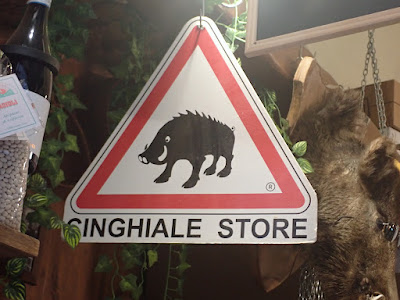 churches,
such as the little one in Todi, are open and airy, and I enjoy the peace and
quiet and spiritual quality of them. Or
the duomo of Spoleto, with Lippi's glowing and realistic frescoes in the apse only – I will go
there every visit. But others, such as
the cathedral in Assisi, is just visually overwhelming. There are
churches,
such as the little one in Todi, are open and airy, and I enjoy the peace and
quiet and spiritual quality of them. Or
the duomo of Spoleto, with Lippi's glowing and realistic frescoes in the apse only – I will go
there every visit. But others, such as
the cathedral in Assisi, is just visually overwhelming. There are 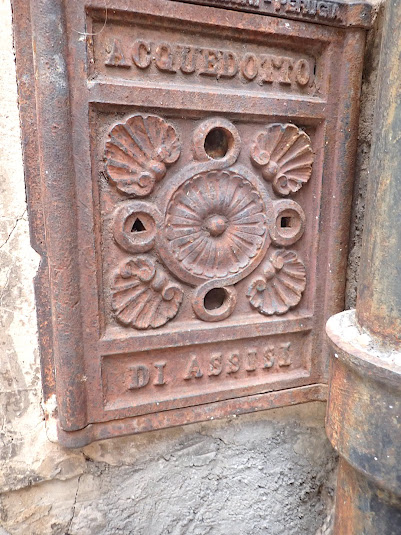 so many frescoes, from the walls to
the vaulted ceilings, that my eyes and brain and soul just go into visual
overload.
so many frescoes, from the walls to
the vaulted ceilings, that my eyes and brain and soul just go into visual
overload.
I’m not
saying don’t visit the cathedral. It’s
worth a visit, especially if you like churches and Medieval art. But, one visit is enough for me. I skipped the cathedral in Assisi.
We had a nice
walk up and down the streets and through the various piazzas. We visited the fabulous hand-made watercolor
store, where I had bought a pocket-sized watercolor set two years ago and used for  painted sketches
on this trip. Also dropped in at the
paper and book store, and I bought myself a beautiful set of stationary with
traditional illuminated designs.
painted sketches
on this trip. Also dropped in at the
paper and book store, and I bought myself a beautiful set of stationary with
traditional illuminated designs.
We managed to
find the outer gate that took us to the parking lot where we would meet our
bus. The walk took us outside the walls
of Assisi, so we were overlooking the very verdant fields of Umbria on our downhill walk, with grey
clouds and bits of fog hanging overhead.
Beautifully scenic. Also rather
damp.
It was a very
full day, and we returned to the school and our rooms after dark. Full of images of weaving, color, frescoes,
and also full of food (and chocolate!).
Another great
day!
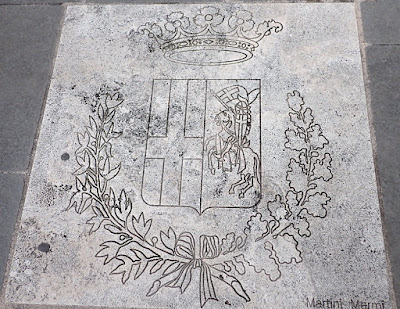





 jar of jam and it’s “spettacolare.” Close enough to understand this will be
spectacular! I like this alimentaria
because it’s definitely not the super-posh fancy touristy kind of spot; it’s a
neighborhood spot, where the owner doesn’t speak English and he jokes around in
Italian with all customers, even the non-Italians like us.
jar of jam and it’s “spettacolare.” Close enough to understand this will be
spectacular! I like this alimentaria
because it’s definitely not the super-posh fancy touristy kind of spot; it’s a
neighborhood spot, where the owner doesn’t speak English and he jokes around in
Italian with all customers, even the non-Italians like us. frescoes
by Filippo Lippi, which are just luminous.
SO gorgeous! After soaking in the
beauty and communing with Lippi (who is buried in the church, despite the
scandals surrounding his history), there’s a little local park just around the
corner from the church. I always visit
this less-known spot, sometimes
frescoes
by Filippo Lippi, which are just luminous.
SO gorgeous! After soaking in the
beauty and communing with Lippi (who is buried in the church, despite the
scandals surrounding his history), there’s a little local park just around the
corner from the church. I always visit
this less-known spot, sometimes  sketching, sometimes just looking at the great
overview of the entire town, full of earth-toned buildings, terra cotta tiled
roofs, and cypress trees dotted around.
sketching, sometimes just looking at the great
overview of the entire town, full of earth-toned buildings, terra cotta tiled
roofs, and cypress trees dotted around.















